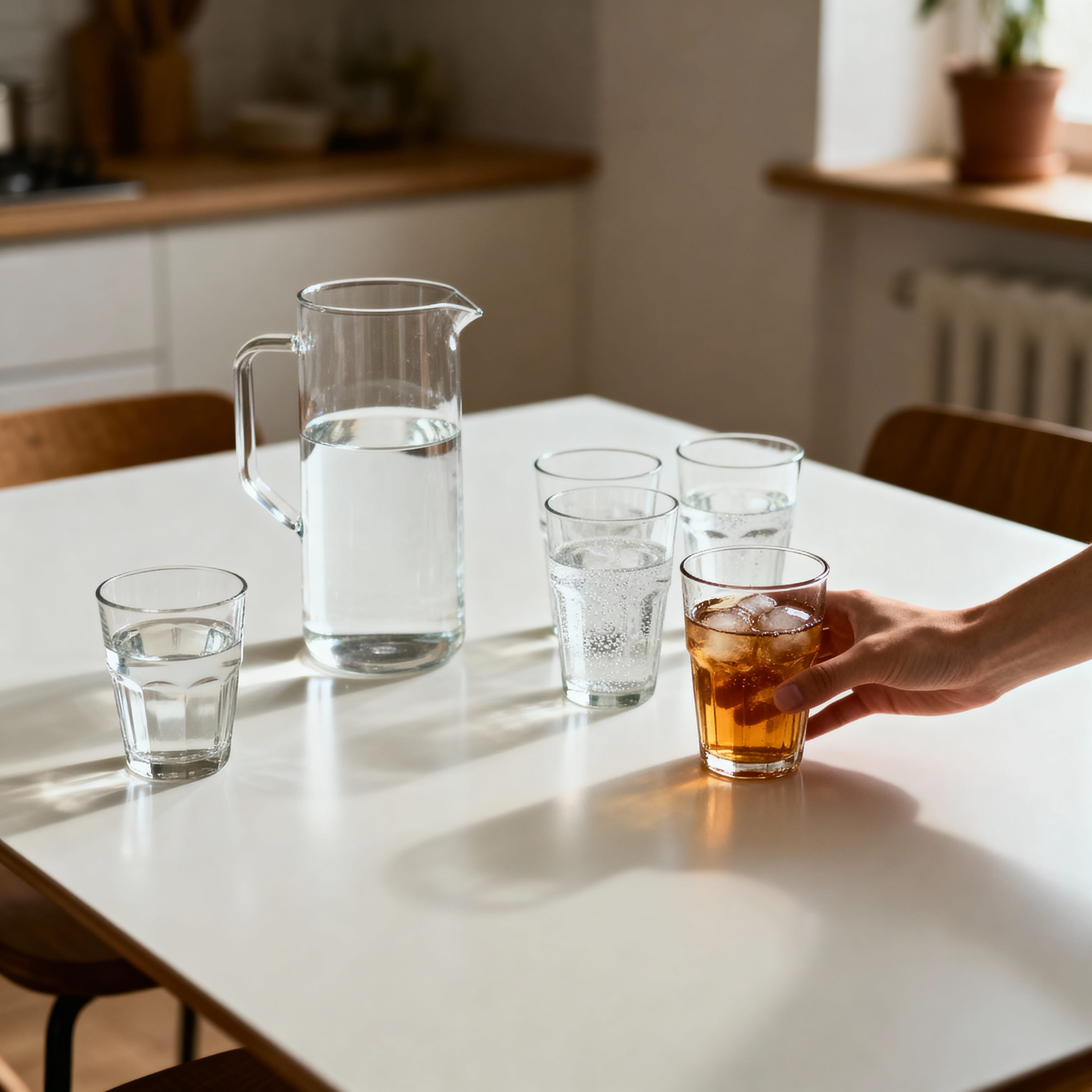What Is Enough Protein On A GLP-1?
Author
glp winnerDate Published
- Twitter
- Facebook
- LinkedIn
- Instagram
- Copy Link

If you are eating less on a GLP-1, protein becomes one of the most important nutrients in your entire routine. Your appetite drops, your meals get smaller, but your protein needs do not shrink. If anything, they go up.
This guide walks through how much protein most people need, how that changes while taking a GLP-1, and simple ways to hit your target without forcing giant meals.
This is general education and not medical advice. Always follow your clinician’s guidance, especially if you have kidney issues or other chronic conditions.
How much protein most adults need
The basic protein minimum for adults is 0.8 grams per kilogram of body weight per day. This is the Recommended Dietary Allowance and is meant to prevent deficiency (National Academies of Sciences, Engineering, and Medicine).
Harvard Health notes that many adults do better with a higher intake, especially during weight loss or as they age. They often recommend 1.2 to 1.6 grams per kilogram per day (Harvard Health).
The Cleveland Clinic echoes this range for people focused on muscle preservation or weight changes (Cleveland Clinic).
A simple reference:
- 120 pounds: about 65 to 90 grams daily (about 2-3 chicken breasts)
- 150 pounds: about 80 to 110 grams daily (about 3-4 chicken breasts)
- 180 pounds: about 100 to 130 grams daily (about 4-5 chicken breasts)
- 200 pounds: about 110 to 145 grams daily (about 5-6 chicken breasts)
These numbers apply to total daily protein from all foods, not a single meal.
Why protein matters so much
Protein breaks down into amino acids, the building blocks for almost every system in your body.
You need protein for:
- Muscle
- Bone and connective tissue
- Hormones
- Enzymes
- Immune function
- Hair, skin, and nails
The Mayo Clinic states that protein should make up about 10 to 35 percent of total daily calories (Mayo Clinic Health System).
But that calorie percentage becomes tricky when you eat less on a GLP-1. If your plate shrinks, each bite matters more.
Why GLP-1 users need more protein, not less
GLP-1 medications slow digestion and reduce appetite. FDA approved examples include semaglutide and tirzepatide for specific indications (FDA: Semaglutide and FDA: Tirzepatide).
When appetite drops, calorie intake drops. That is the goal. But your body needs enough protein to protect muscle during weight loss.
Here is the important part:
A study published in Obesity found that people using GLP-1 medications can lose both fat and lean mass during weight loss (Obesity Journal).
A JAMA Internal Medicine review explains that muscle loss can be reduced by combining protein with strength training and intentional eating patterns (JAMA Internal Medicine).
Muscle matters for:
- Strength
- Mobility
- Metabolism
- Blood sugar control
- Long term health
Protein is one of the simplest tools to help protect it.
Practical protein targets for GLP-1 users
Putting the research together, most clinicians recommend:
- Minimum:
0.8 grams per kilogram per day - Better target during GLP-1 treatment:
1.2 to 1.6 grams per kilogram per day (Harvard Health and Cleveland Clinic linked above) - Higher end if applicable:
You lift weights
You are older
You are recovering from illness
Your clinician advises it
This range supports muscle while still allowing fat loss.
Always check with your clinician if you have kidney disease, since protein needs may be different.
What this looks like in real food
Approximate protein amounts:
- 3 ounces chicken or turkey: 25 grams
- 3 ounces fish or shrimp: 20 to 22 grams
- 2 eggs: 12 grams
- 1 cup cottage cheese: 24 grams
- ¾ cup Greek yogurt: 15 to 18 grams
- ½ cup lentils or black beans: 8 to 9 grams
- 3 ounces tofu or tempeh: 12 to 15 grams
- ¼ cup nuts or seeds: 5 to 8 grams
The Academy of Nutrition and Dietetics confirms these values as safe estimates (Academy of Nutrition and Dietetics).
When appetite is low, softer or easier proteins like yogurt, cottage cheese, eggs, or tofu often work better than heavier meats.
Sample day of about 90 grams of protein
Breakfast
- 2 eggs (12 g)
- Greek yogurt (17 g)
Total: 29 g
Lunch
- Chicken salad with beans (25 to 30 g)
Snack
- Cottage cheese or a small shake (15 to 20 g)
Dinner
- Salmon or tofu (20 to 25 g)
That lands around 80 to 100 grams depending on portions.
Gender, weight, and lifestyle factors
- Gender
Protein formulas are based on body size, not gender. Men often weigh more and naturally have higher targets. - Weight
Higher weight = higher total protein needs using the same equation. - Activity
Strength training increases protein needs, especially while losing weight.
The National Institute on Aging recommends protein intake spaced evenly across the day for muscle health (National Institute on Aging).
How protein fits with carbs and fats
Protein is the anchor. Carbs give energy and fiber. Fats give long lasting satisfaction and support hormones.
Keeping protein steady helps:
- Support blood sugar stability
- Reduce hunger swings
- Make smaller meals more filling
The American Heart Association encourages choosing lean meats, beans, and plant-based proteins (American Heart Association).
GLP-1 specific eating strategies
People on GLP-1s often deal with nausea or early fullness. These tips match guidance from the Cleveland Clinic and Mayo Clinic:
- Cleveland Clinic eating tips (Cleveland Clinic)
- Mayo Clinic nausea management (Mayo Clinic)
Helpful strategies:
- Start meals with your protein bites first
- Spread protein across the day
- Avoid drinking large amounts of fluid right before or during meals
- Choose softer proteins on rough days
- Use small, simple meals instead of large plates
Can you get too much protein?
For most people with healthy kidneys, higher protein intakes (up to about 1.6 to 2.0 g per kg) are generally considered safe (Cleveland Clinic).
But extremely high intakes can crowd out other nutrients and may be a concern for people with kidney problems.
If you have kidney disease or a history of stones, follow your doctor’s advice before increasing protein.
Plant based proteins count too
A well planned plant based diet can meet your protein needs.
The Academy of Nutrition and Dietetics confirms that plant-based diets can provide adequate protein when varied (Academy of Nutrition and Dietetics).
Plant proteins often require slightly larger portions or more variety, but they absolutely count.
When to ask for help
You might need a clinician or dietitian if:
- You lose weight quickly and feel weak
- You cannot hit even the lower protein range
- You have kidney or liver issues
- You feel confused about mixing GLP-1 eating with other conditions
If you are struggling to get clear guidance, you can compare telehealth providers on GLP Winner to find options that emphasize nutrition support and GLP-1 education (GLP Winner).
Compounded GLP-1 medications exist but are not FDA approved. Their safety and effectiveness have not been established. A clinician can help you understand if they are appropriate only in the context of documented need or shortage.
FAQ
Do I need a protein shake on a GLP-1?
Not always. Shakes help when appetite is low, but foods like yogurt, eggs, fish, beans, and tofu can meet your protein needs.
How much protein per meal?
Aim for 20 to 30 grams per meal. This helps support muscle and fullness when total calories drop.
What happens if I do not get enough protein?
You may lose more muscle during weight loss. You may feel weaker or more tired.
Can plant proteins work just as well?
Yes. Mix your sources to get complete amino acids.
Is high protein safe on GLP-1s?
It is safe for most healthy adults but not for people with kidney issues. Always check with your doctor.
If you enjoy posts like these, you can subscribe to receive newsletter updates.
Sources
Keep Reading

Night food noise can still happen on GLP-1s. Learn why cravings show up at night and simple ways to calm them so evenings feel easier.

Learn what to expect before starting a GLP-1 — supplies, mindset, telehealth basics, safety tips, and how to prepare for your first dose.

Learn how hydration works on GLP-1s—what counts, what doesn’t, and how to avoid nausea by timing your fluids the right way.
